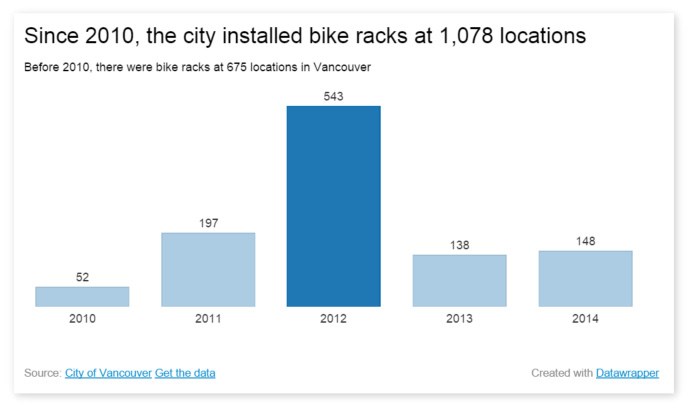If you walked past a café, restaurant or craft brewery this summer, you would have seen the familiar sight of bicycles locked to fences, railings, trees, signposts, and parking meters. Basically anywhere but to a secure bike parking structure.
On one hand, these overflowing racks are a sign of progress. A side effect of Vancouver’s move toward a more bike-friendly city where pedalling to your destination is a safe, attractive and normal part of everyday life.
On the other hand, they are the most visible sign of a bike parking shortage. Despite infrastructure investments and increases in ridership, city bike parking policy remains reactive — rather than proactive — and has failed to keep pace with this modal shift.
The availability of dependable, convenient bike parking has repercussions on where and when people will stop to spend their money. I’ve lost count of the number of times our family of four has pedalled up to a shop, found there is nowhere we felt comfortable locking up, and decided to take our business to another location down the street.
Commuting makes up only makes up 20 per cent of bike trips. The rest — for shopping, dining, banking, and so on — gets overlooked. But without a secure place to lock up, the bike is more likely to get left at home.
It’s impossible to discuss a lack of bike parking without mentioning its effect on bike theft. Last year, a friend’s bike was stolen after he was resigned to locking it to a tree. When he returned, his bike was gone and the tree sawn in two. A small number — — of these victims don’t replace their stolen bike and revert to other, less active forms of transport. Others are hesitant to invest in a bike that suits their needs, choosing to ride around on an inexpensive, uncomfortable, and ill-fitted machine.
To its credit, the city Ěýand has done so roughly 1,100 times since 2010. But these are far from ideal racks since they provide room for two to four bicycles on an often narrow, overcrowded sidewalk.
ĚýIt is increasingly clear that a bold reallocation of road space and funding must be matched with an equally bold plan for bike parking.
The most simple, cost-effective way to address this inadequacy is with a bike corral, one of which was built outside the J.J. Bean coffee shop on Commercial Drive in 2010. Owner John Neate swapped two on-street car parking spaces for room to park 20 bikes. At the time he called it a “godsend” and intends to install more at other locations.

There really is no reason why corrals can’t be placed outside popular hotspots such as the Alibi Room, Brassneck Brewery, Main Street Brewing and St. Augustine’s. Since 2004, Portland has converted 120 on-street parking spots to make room for more than 2,400 bikes. Businesses now sign up to a two-year-long waitlist.Ěý
A solution lies somewhere between private enterprise and public responsibility. The former must recognize the impact to their bottom line, and the latter must provide t the tools to address it. Until then, our cycling family will continue spending our money where we are made to feel welcome. If Â鶹´«Ă˝Ół»is serious about becoming a great cycling city, we can’t ignore our bike parking problem.
Chris Bruntlett is a co-founder of Modacity and is inspired to live a happy life of urban mobility. Reach him at[email protected].


